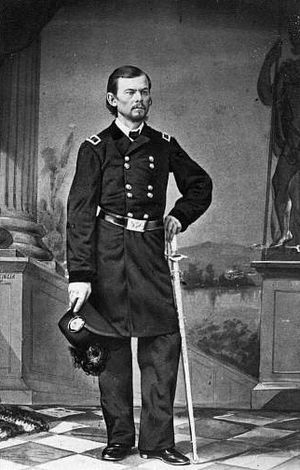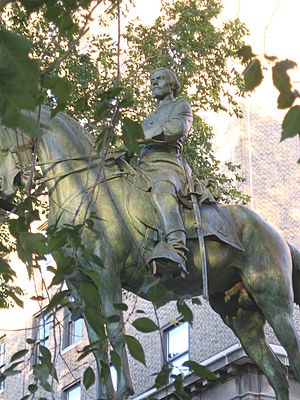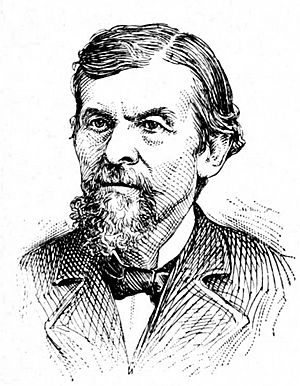Franz Sigel facts for kids
Quick facts for kids
Franz Sigel
|
|
|---|---|

Franz Sigel
|
|
| Born | November 18, 1824 Sinsheim, Baden, Germany |
| Died | August 21, 1902 (aged 77) New York City, New York |
| Place of burial |
Woodlawn Cemetery, The Bronx, New York
|
| Allegiance | Baden Revolutionaries |
| Service/ |
Baden Army Baden Revolutionary Forces United States Army |
| Years of service | 1843–1847 (Baden) 1848 (Revolutionaries) 1861–1865 (USA) |
| Rank | Lieutenant (Baden) Colonel (Baden Revolutionaries) |
| Commands held | XI Corps |
| Battles/wars | |
| Signature | |
Franz Sigel (born November 18, 1824 – died August 21, 1902) was a brave German-American soldier and leader. He moved to the United States and became a teacher, newspaper writer, and politician. During the American Civil War, he served as a Union major general. President Abraham Lincoln liked Sigel because he was very good at getting German-speaking immigrants to join the Union army. However, General-in-Chief Henry Halleck did not like him very much.
Contents
Early Life and Revolution
Sigel was born in Sinsheim, a town in Baden, Germany. He went to a special high school called a gymnasium. In 1843, he finished military school in Karlsruhe. He became a lieutenant in the army of Baden.
Sigel met important revolutionaries like Friedrich Hecker. He joined their movement, which wanted more freedom for people. In 1847, he left the army to study law.
Soon, Sigel became a leader in the Baden Revolution of 1848. He was one of the few revolutionaries with real army experience. In April 1848, he led over 4,000 volunteers to attack the city of Freiburg. His group was defeated by the Baden army.
In 1849, Sigel became the Secretary of War for the revolutionary government. He was also their commander-in-chief. After being hurt in a fight, he still helped the war effort. When the revolutionaries were defeated, Sigel led the remaining troops to safety in Switzerland. He later moved to England.
In 1852, Sigel moved to the United States. Many other German revolutionaries, known as Forty-Eighters, also came to America.
Life in America
In the United States, Sigel first taught in public schools in New York City. He also joined the state militia. Later, he became a professor in St. Louis, Missouri. In 1860, he was chosen to be the director of St. Louis public schools.
Sigel was very important to the German immigrant community. He encouraged many Germans to support the Union and to oppose slavery. This support was very helpful when the Civil War began.
Serving in the Civil War
When the Civil War started, Sigel became a colonel in the 3rd Missouri Infantry. He helped capture Camp Jackson in St. Louis in May 1861.
President Lincoln wanted to gain the support of immigrants who were against slavery. Sigel was popular with German immigrants, so he was a good choice. In August 1861, he was promoted to brigadier general.
Early Battles in Missouri
In June 1861, Sigel led his troops to Springfield. He then moved to Carthage. He wanted to stop Confederate troops from escaping.
At the Battle of Carthage on July 5, Sigel's smaller force was pushed back. This battle was not very important, but it encouraged more people to join the Confederate side.
Sigel then joined his troops with General Nathaniel Lyon's army. They went after the Confederate State Guard. At the Battle of Wilson's Creek on August 10, Sigel's troops attacked the enemy from behind. However, his group was defeated. After General Lyon was killed, Sigel took command and led the army's retreat.
Key Victories and Challenges
In early 1862, Sigel led two divisions in the Army of the Southwest. This army moved into Arkansas. They fought Confederate troops at the Battle of Pea Ridge on March 8-9. This was one of Sigel's best performances. His troops fought well, and he personally directed the Union cannons. This attack helped defeat the Confederates.
Sigel was promoted to major general on March 21, 1862. He then commanded a division in the Shenandoah Valley. Here, he struggled against Confederate General Thomas J. "Stonewall" Jackson. Jackson was very clever and defeated Sigel's larger Union force in several small fights.
Sigel later commanded the I Corps at the Second Battle of Bull Run. This was another Union defeat, and Sigel was wounded in the hand.
Leading the XI Corps
During the winter of 1862–63, Sigel commanded the XI Corps. This corps was mostly made up of German immigrant soldiers. Many of these soldiers spoke little English. Their proud slogan was "I'm going to fight mit Sigel." This became a popular song during the war.
Sigel was not always seen as a skilled general. However, he was very good at getting German immigrants to join the army. This made him important for political reasons.
In February 1863, Sigel left the XI Corps. He was replaced by Major-General Oliver O. Howard. The XI Corps later faced difficulties at the battles of Chancellorsville and Gettysburg, but Sigel was no longer in command.
General Henry W. Halleck did not like Sigel. He kept Sigel in less important roles until March 1864. However, President Lincoln wanted Sigel to have a command. So, he was put in charge of the new Department of West Virginia.
Final Campaigns
In his new role, Sigel began the Valley Campaigns of 1864. He led an invasion of the Shenandoah Valley. But on May 15, 1864, he was defeated by Confederate Maj. Gen. John C. Breckinridge at the Battle of New Market. This defeat was especially embarrassing because young cadets from the Virginia Military Institute played a big part in it. After this battle, Sigel was replaced.
Sigel spent the rest of the war without an active command.
After the War
Franz Sigel left the army on May 4, 1865. He worked as a newspaper editor in Baltimore and then in New York City. He held several political jobs there, working with both the Democrats and the Republicans.
In 1887, President Grover Cleveland made him a pension agent for New York City. Sigel also gave lectures and worked in advertising. For some years, he published a German-American magazine called New York Monthly.
Franz Sigel passed away in New York in 1902. He is buried in Woodlawn Cemetery in The Bronx, New York City.
Honors and Legacy
Franz Sigel is remembered with statues in several places. There is one in Riverside Park in Manhattan, New York City. Another statue stands in Forest Park in St. Louis, Missouri.
A park in the Bronx, near Yankee Stadium, is also named after him. Streets in Williamsburg, Brooklyn and Worcester, Massachusetts are named Sigel Street. The villages of Sigel, Pennsylvania (founded 1865) and Sigel, Illinois (settled 1863) also carry his name. Sigel Township, Minnesota, organized in 1862, was named for him too.
See also
 In Spanish: Franz Sigel para niños
In Spanish: Franz Sigel para niños
- List of American Civil War generals (Union)
- German Americans in the Civil War



